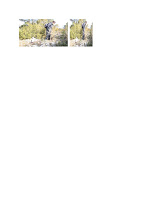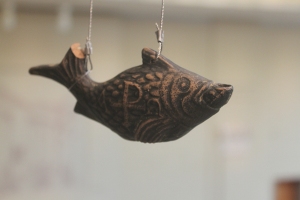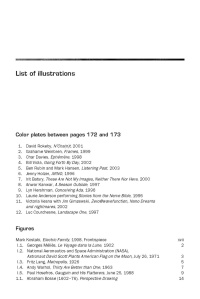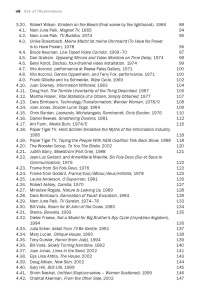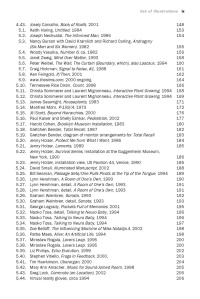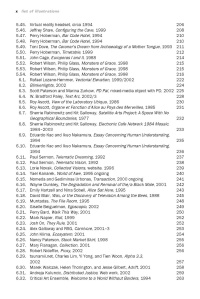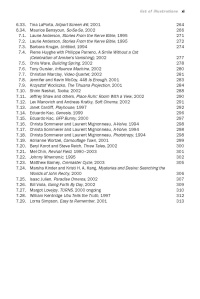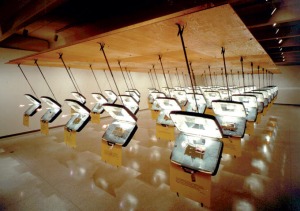1. David Rokeby, N’Cha(n)t, 2001
2. Grahame Weinbren, Frames, 1999
3. Char Davies, Ephomere, 1998
4. Bill Viola. Going Forth By Day, 2002
5. Ben Rubin and Mark Hansen, Listening Post, 2003
6. Jenny Holzer. ARNO, 1996
7. Irit Batsry, These Are Not My Images, Neither There Nor Here, 2000
8. Anwar Kanwar, A Season Outside, 1997
9. Lyn Hershman, Conceiving Ada, 1996
10. Laurie Anderson performing Stories from the Nerve Bible. 1995
11. Victoria Vesna with Jim Gimzewski, Zeroawavefunction, Nano Dreams and nightinares, 2002
12. Luc Courchesne. Landscape One. 1997
Figures
Mark Kostabi, Electric Family. 1998, Frontispiece
I.1. Georges Melies. Le Voyage dans Lune
I.2. National Aeronautics and Space Administration (NASA), Astronaut David Scott Plants American Flag on the Moon, July 26, 1971
I.3. Fritz Lang, Metropolis, 1926
I.4. Andy Warhol. Thirty Are Better than One, 1963
I.5. Paul Hosefros, Gauguin and His Flatterers, June 25. 1988
1
1.1. Abraham Bosse (1602-76), Perspective Drawing
1.3. Early camera obscure. from A. Kircher, Ars Magna Lucis et Umbrae. 1645
1.4. Camera obscure, circa seventeenth century
1.5. Camera lucida, circa eighteenth century
1.6. Jan Vermeer. Young Girl With A Flute, 1665
1.7. Theodore Maurisset, La Daguerreotypomanie, 1839
1.8. Eadweard Muybridge, Woman Kicking, 1887
1.9. Raoul Hausmann, Tatlin at Home. 1920
1.10. John Heartfield, Hurrah, die Butter ist All, (Hurrah, the Butter Is Gone!), 1935
1.11. Lumiere Brothers, frames from Un Train Arrive en Gare. 1896
2
2.1. Etienne-Jules Marey. Chronophotographe Geometrique, 1884
2.2. Giacomo Balla, Swifts: Paths of Movement + Dynamic Sequences, 1913
2.3. Marcel Ducharnp, Nude Descending a S.ircase, No. 21912
2.4. Vladimir Tatfin, Monument for the Third International. 1920
2.5. 211810 Moholy-Nagy, Light Space Modulator. 1923-30
2.6. Dziga Vertov, Man with a Movie Camera, 1929
2.7. Marcel Duchamp, The Large Glass or The Bride Stripp. Bare by Her Bachelors, Even, 1915-23 (replica: 1961)
2.8. Charlie Chaplin, Modern Times, 1936
2.9. James Rosenquist Working in Times Square, 1958
2.10. James Rosenquist. Love You with My Ford, 1961
2.11. Andy Warhol, Green Coca-Cola Bottles. 1962
2.12. Andy Warhol, Electric Chair, 1965
2.13. Roy Lichtenstein, Hopeless, 1963
2.14. Eduardo Paolozzi, Artificial Sun. 1965
2.15. Richard Hamilton, Kent State, 1970
3
3.1. Robert Rauschenberg, Signs, 1970
3.2. Keith Haring, Untitled, 1983
3.3. John Baldessari, I Will Not Make Any More Boring Art, 1971
3.4. Mark Tansey, Secret of the Sphinx, 1984
3.5. Jean Dupuy. Jean Tinguely, and Alexander Calder with Heart Bea. Dust, .69
3.6. Jean Dupuy. artist, and Ralph Martel, engineer, Heart Beats Dust 1968
3.7. Pepsi-Cola Pavilion. Osaka, 1970
3.8. Remy Charlip, Homage to Loie Fuller, March 8, 1970
3.9. Merce Cunningham, John Cage and Stan Van 081 8880. Variations V, 1965
3.10. Barbara Kruger, Untit/ed, 1982
3.11. Carolee Schneemann, Cycladic imprints, 1993
3.12. Adrian Piper, What it’s Like, What lt Is, #3, 1.4
3.13. Damien Hirst, Hymn, 2001
3.14. Stelarc, Amplifi. Body, Automat. Arm and Third Hand, 1992
3.15. Larry List, An Excerpt from the History of the World, 1990
3.16. John Craig Freeman, Rocky Fla. Billboards, 1994
3.17. Mierle Laderman Ukeles, Touch Sanitation Show, 1.4
3.18. Krzysztof Wodiczko. Projection on the Hirshhorn Museum. 1988
3.19. Christo and Jeanne Claude, Wrapped Reichstag. Berlin, 1995
3.20. Robert Wilson, Einstein on the Beach (final scene by the lightboard), 1986
4
4.1. Nam June Paik, Magnet TV, 1965
4.2. Nam June Paik, TV Buddha, 1974
4.3. Ulrike Rosenbach, Meine Macht Ist meine Ohnmacht (To Have No Power Is to Have Power),
1978
4.4. Bruce Nauman, Live Tap. Video Corridor, 1969-70
4.5. Dan Graham, Opposing Mirrors and Video Monitors on Time Delay, 1974
4.6. Beryl Korot, Dachau, four-channel video installation, 1974
4.7. Vito Acconci, performance at Reese Paley Gallery. 1971
4.8. Vito Acconci. Dennis Oppenheim, and Terry Fox, performance, 1971
4.9. Frank Gillette and Ira Schneider, Wipe Cycle, 1969
4.10. Juan Downey, Information Withheld, 1983
4.11. Doug Hall, The Terrible Uncertainty of the Thing Described, 1987
4.12. Martha Rosler. Vital Statistics of a Citizen, Simply Obtained, 1977
4.13. Dara Birnbaum, Technology/Transformation: Wonder Woman, 1978/9
4.14. Joan Jonas. Double Lunar Dogs, 1984
4.15. Chris Burden, L.nardo, Michelangelo, F?embrandt, Chris Burden, 1976
4.16. Daniel Reeves, Smothering Dreams. 1981
4.17. Ant Farm, Media Burn, 1974/5
4.18. Paper Tiger TV, Herb Schiller Smashes the Myths of the Information Industry, 1985
4.19. Paper Tiger TV, Taping the People With AIDS Coalition Talk Back Show, 1988
4.20. The Wooster Group, To You The Birdie. 2002
4.21. Judith Barry. Maelstrom (Part One), 1988
4.22. Jean-Luc Godard, and Anne,Marie Motility, Six Fois Deux (Sur et Sous la Communication), 1976
4.23. Frame from Six Fois Deux, 1976
4.24. Frame from Godard, France/tour/detour/deux/enfants, 1978
4.25. Laurie Anderson, 0 Superman, 1981
4.26. Robert Ashley, Cami//a, 1970
4.27. Miroslaw Rogala. Nature Leaving Us. 1989
4.28. Dara Birnbaum, Damnation of Faust: Evocation, 1984
4.29. Nam June Paik, TV Garden, 1974-78
4.30. Bill Viola, Room for St John of the Cross, 1983
4.31. Stein, Borealis. 1993
4.32. Dieter Froese, Not a Model for Big Brother. Spy Cycle (Unprazise Angaben), 1984
4.33. Julia Scher, detail frorn /’// Be Gentle, 1991
4.34. Mary Lucier, Oblique House, 1993
4.35. Tony Oursler, Horror (from Judy), 1994
4.36. Bill Viola, Slowly Turning Narrative, 1992
4.37. Joan Jonas, Lines in the Sand, 2002
4.38. Eija Liisa Ahtila, The House, 2002
4.39. Doug Aitken, New Skin, 2002
4.40. Gary Hill. Still Life, 1999
4.41. Shirin Neshat. Untitled (Rapture series – Women Scatter.), 1999
4.42. Chantal Akerman, Froth the Other Side, 2002
5
6
